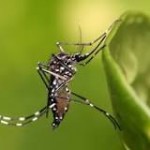Severe outbreaks of vector-borne infectious diseases and their geographic expansion pose a serious threat to vulnerable populations. Over 2.5 billion people living in tropical and sub-tropical climates are at potential risk of contracting dengue fever, which has become the most important vector-borne viral disease in the world. Current estimates suggest up to 100 million dengue cases occur annually, of which 1 million cases require hospitalization. Across Latin America, despite efforts in the 1940s to eradicate the vectors, dengue has gradually re-emerged due to a re-emergence of the vector, population growth, poorly-planned urbanization, increased global travel, diversification of viral strains, global warming, and insecticide resistance.
Dengue fever transmission results from complex interactions between the virus, human hosts, and female Aedes aegypti mosquito vectors – all of which are influenced by environmental factors. A dengue early warning system aims to anticipate periods when environmental conditions are most favorable for an outbreak so timely decisions regarding public awareness, vector control, and disease prevention strategies can be initiated in a cost-effective manner. The over-arching goal of this study was to develop spatiotemporal models which predict dengue incidence rate based on local weather, regional climate, land-use, population, and socioeconomic factors for use as an early warning system.
Our research focused on Colombia, South America, with specific efforts in the city of Cali, a dynamic urban environment in central Colombia. Thus, far we have (a) developed intraseasonal and interseasonal autoregressive predictive models for dengue outbreaks in Cali using local weather and regional climate parameters (Eastin et al. 2014), (b) developed spatiotemporal models for dengue outbreaks in Cali using a combination of local weather and socioeconomic parameters (Desjardin et al. 2020) and (c) developed a high-resolution, spatiotemporal, autoregressive model for intraseasonal dengue outbreaks across Colombia using elevation, land cover, population density, and local weather parameters (Sirbaugh 2017)
This line of research was a collaborative effort with Dr. Eric Delmelle (Lehigh University) and Dr. Irene Cases (Louisiana Tech University) and was funded by grants from UNC Charlotte.
Relevant Publications:
Desjardin, M., M.D. Eastin, P. Rajib, I. Casas, and E. Delmelle, 2020: Space-time conditional autoregressive modeling to predict neighborhood-level risks for dengue fever in Cali, Colombia. American Journal of Tropical Medicine and Hygiene, 103(5), 2040–2053.
Sirbaugh, M.E., 2017: Spatiotemporal prediction of dengue fever in Colombia, South America, based on temperature and precipitation. M.S. Thesis, UNC Charlotte. (Advisor: M.D. Eastin)
Eastin, M.D., E. Delmelle, I. Casas, J. Wexler, and C. Self, 2014: Intra- and inter-seasonal autoregressive prediction of dengue outbreaks using local weather and regional climate for a tropical environment in Colombia. American Journal of Tropical Medicine and Hygiene, 91(3), 598-610.
